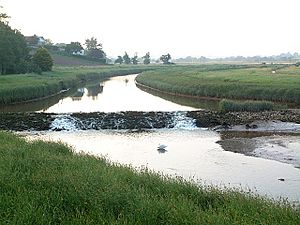River Clyst facts for kids

The River Clyst is a lovely river in Devon, England. It flows through beautiful countryside. The name "Clyst" comes from an old English word. It means "Clean-stream," which tells us the water was once very clear! Many towns along its path are named after the river. These include Clyst Honiton and Broadclyst. The "William" in Clyst William also has an old meaning. It comes from a word that means "river source."
Contents
The River Clyst's Journey
The River Clyst begins its journey near Clyst William. This small village is close to Cullompton. From there, the river flows for about 38 kilometers (24 miles). It travels west and then southwest.
Towns Along the Way
As the river flows, it passes through several villages. These include Norman's Green and Plymtree. It also goes through Clyst Hydon and Clyst St. Lawrence. After passing Westwood, the river enters the wide Clyst Valley.
Flowing South to the Sea
The River Clyst then turns south. It winds its way through Broadclyst and West Clyst. Further along, it passes Clyst Honiton and Clyst St. Mary. Finally, it flows past Clyst St. George. The river then joins the Exe estuary. This happens at RSPB Bowling Green Marsh, near Topsham. On average, the river sends about 1.3 cubic meters of water into the estuary every second. The river's water level changes with the tides from the Exe estuary. This tidal part reaches as far as Newcourt Barton.
New Bridge for Cyclists and Walkers
In 2011, work began on an exciting new bridge. This bridge crosses the River Clyst at Fishers Mill in Topsham. It was built for people to cycle and walk. This project is part of the Sustrans’ National Cycle Network.
Connecting Trails
The new bridge helps connect to the Exe Estuary Trail. This trail is part of National Cycle Network Route 2. The bridge officially opened in November 2013. Plans included a long wooden walkway. This walkway stretches 225 meters (738 feet) over the salt marshes. The main bridge section spans 120 meters (394 feet) across the river itself. This new bridge is located downstream from an older, narrow stone bridge. That old bridge is a Grade II listed building.
Wildlife and Nature Along the Clyst
The area around the River Clyst is a great place for wildlife. In winter, the flood plain becomes home to many birds. Large groups of Brant geese and Canada geese gather here.
Bowling Green Marsh Reserve
On the north side of the Clyst, there is a special place. It's called RSPB Bowling Green Marsh. This is a small nature reserve run by the RSPB. It has a hide, which is a small building. From the hide, you can watch the birds without disturbing them.
Protecting the River's Health
In 1988, there was a diesel oil spill in the estuary. This spill threatened the homes of the birds and other animals. Special equipment was used to remove the 5,000 gallons of oil. This helped protect the river's environment.
Fish Species in the River
A survey in 1994 looked at the fish in the River Clyst. It found several types of fish. These included bullhead, dace, and eel. Minnow, stone loach, and stickleback were also present. Mullet and flounder were found too. The only salmon-like fish found were some trout. These trout were in one of the smaller streams that flow into the Clyst. By 2008, people were concerned about the river's water quality. They noted that there were high levels of pollution.
Images for kids


